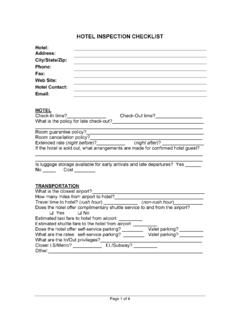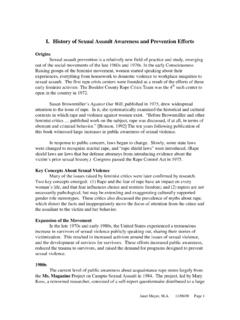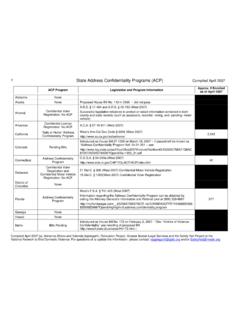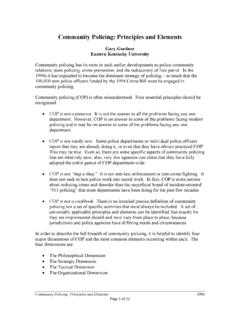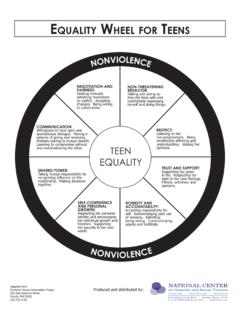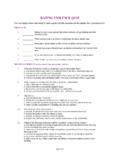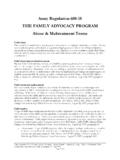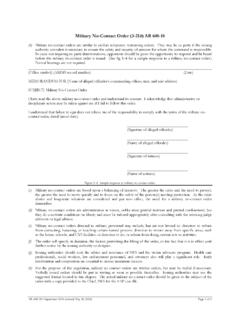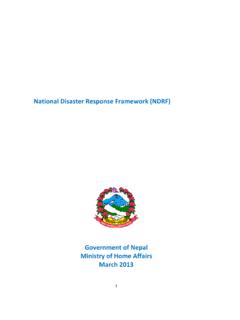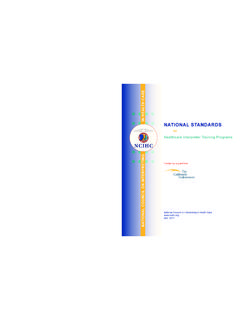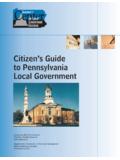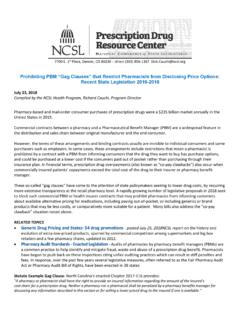Transcription of ARNG Information Guide - National Center on …
1 Army National Guard Information Guide On Non-Regular Retirement 15 April 2009. Compiled by United States Army National Guard and Retirement Services, arng LNO. FORWARD: This Guide is designed for anyone with an interest in how a member of the Army National Guard can earn retirement points credit, qualify for retired pay for non- regular service, apply for retired pay, and all the many factors that affect each of these areas. The rules, links, and references are not the definitive answer on any subject covered here. All are subject changes in laws, directives, regulations and the determinations of the offices and agencies responsible for the Information assembled and presented here. For matters concerning individual Retirement Points Accounting, contact the RPAM.
2 Administrator (Retirement Points Accounting Management Administrator) for the state in which the Soldier is a member or held membership. For specific determinations of retirement eligibility, the RPAM Administrator can refer questions to Human Resources Command St Louis (HRC-St Louis). Send comments and recommendations on this Guide to the Personnel Policy and Readiness Division at: Chief, NGB, ATTN: NGB-ARH, 1411. Jefferson Davis Highway, Arlington, VA 22202-3231. Table of Contents Contents (Listed by subject and paragraph number). Chapter 1. Introduction Purpose 1-1. Background 1-2. Chapter 2. Non-Regular Service Retirement Qualifying years of satisfactory service 2-1. Establishing anniversary years 2-2.
3 Adjustments and exceptions to anniversary years 2-3. Partial years 2-4. Limits on retirement points 2-5. Retirement credits by activity 2-6. Retirement Points Accounting Management (RPAM) system 2-7. Chapter 3. Eligibility for Retired Pay for Non-Regular Service Eligibility 3-1. Qualifying years of service 3-2. Additional requirements 3-3. Physical disabilities 3-4. Notifications of eligibility 3-5. Status upon receipt of 20 Year NOE 3-6. Reissuance of the 15 or 20 Year NOE 3-7. Chapter 4. Separation from Active Status and Continuation Eligibility 4-1. Separation Authority 4-2. Serving in the arng until age 60 4-3. Grade in which retired 4-4. Assignment to the Retired Reserve 4-5. Recall and return to service 4-6.
4 Military service recognition 4-7. Chapter 5. Application for Retired Pay Basic requirements 5-1. Responsibilities to retirees 5-2. Eligibility ages 5-3. Processing retirement packets 5-4. Calculation of Retired Pay 5-5. Matters of pay grades 5-6. Chapter 6. Retiree Benefits and Related Matters Defense Enrollment Eligibility Reporting System (DEERS) 6-1. Benefits before receipt of retired pay 6-2. Benefits upon receipt of retired pay 6-3. Chapter 7. Retirement Briefings Content and structure 7-1. Resources 7-2. Outside agencies 7-3. Information sources 7-4. Chapter 8. Death Notification and Annuity Claim Procedures Death Notification Procedures 8-1. Processing a Claim for Survivor Benefit Plan (SBP) 8-2.
5 Death of Retiree 8-3. Appendixes Appendix A. References A-1. Appendix B. Reserve Component Survivor Benefit Plan (RC-SBP). Overview B-1. RC-SBP Options B-2. RC-SBP Elections B-3. RC-SBP Premiums and Benefits B-4. Survivor's RC-SBP Annuity B-5. RC-SBP Election, Active Service Retirement B-6. Distribution of RC-SBP Election Form B-7. Change Forms B-8. SBP Termination B-9. Additional Information pertaining to RC-SBP B-10. Appendix C. Automatic Election Memorandum for RC-SBP C-1. Appendix D. Death Notification Procedure Memorandum D-1. Appendix E. Presidential Recognition Upon Retirement E-1. Appendix F. Important Documents F-1. Appendix G. Table of Retiree Benefits G-1. Appendix H. TRICARE Benefit H-1.
6 Appendix I. Department of Veterans Affairs (VA) Entitlements VA Benefits and Selected Reserve I-1. Eligibility for arng Soldiers I-2. Health Care I-3. Combat Veterans Eligibility for VA Health Care Benefits Extended I-4. Concurrent Receipt and Combat-Related Special Special Compensation (CRSC) I-5. Education I-6. Dependent's and Survivors' Benefits I-7. Vocational Rehabilitation and Employment I-8. VA Life Insurance I-9. Home Loan Guaranty I-10. Burial Benefits I-11. VA Contact Information I-12. Appendix J. Social Security Administration Military Service and Social Security J-1. Death of Retiree or Family member J-2. Appendix K. Defense Finance and Accounting Service (DFAS). Defense Retiree and Annuitant Pay System (DRAS) K-1.
7 Cost of Living Allowance (COLA) and Consumer Price Index (CPI) K-2. My Pay link K-3. Retiree Seminars K-4. Glossary Chapter 1. Introduction 1-1. Purpose This Guide provides Information pertaining to earning credit towards retired pay for non-regular service and all related matters. This Information is provided to complement official Information for arng Soldiers as they approach and enter the retired stage of their military lives. It does not replace existing guidance provided by Human Resources Command, St. Louis (HRC-STL) in AR 135-180, Qualifying Service for Retired Pay Non-regular Service, and other instructions and Information provided by them. 1-2. Background Retired pay for non-regular service, the complement to retired pay granted to Regular and other members at the end of at least 20 years of active service, was authorized for members of the Reserve Component in 1949.
8 There have been few changes over the years, such as the requirement for the 20 Year Notification of Eligibility for Retired Pay at Age 60 (NOE) in 1966, referred to throughout the Guide as the 20 Year NOE, and the several laws and programs that have resulted in the Reserve Component Survivor Benefit Plan (RC-SBP). The 60-points Inactive Duty Training (IDT) limit per anniversary year has been changed several times, as well, resulting in the limit today of 130 IDT points per year. There have also been the addition of Inactive Duty Funeral Honors Duty points not subject to the IDT point caps, the Temporary Early Retirement Authority, currently not authorized, to help draw-down the forces when needed, the authorization to issue a 15 Year Letter Notification of Eligibility for Retired Pay at Age 60 (NOE), referred to throughout this Guide as the 15 Year NOE, for retired pay for individuals disqualified from continued military service due to medical disqualification or disability, and most recently, the implementation of a reduced eligibility age for the payment of retired pay for periods of service performed under certain conditions.
9 Chapter 2. Non-regular Service Retirement 2-1. Qualifying years of satisfactory service a. Soldiers must have 20 qualifying years of service to be eligible for retired pay for non- regular service. A qualifying year is an anniversary year in which Soldiers earn at least 50. retirement points from all sources. b. Soldiers who do not earn at least 50 points during a full anniversary year will receive credit for the points they earned, but the year cannot be counted as one of the 20 qualifying years required for eligibility for retired pay for the points earned, in accordance with NGR 680-2. Extra points earned in one anniversary year cannot be carried to another anniversary year in order to claim that year as a qualifying year.
10 Each anniversary year has to stand on its own. 2-2. Establishing anniversary years Anniversary years are full-year periods calculated from anniversary year dates. These years are established, with the exceptions listed in paragraphs 2-3 and 2-4 below, upon entry into an active status in any component of military service, Regular or Reserve, effective 1 October 1995. Prior to 1 October 1995, anniversary years were established upon entry into a Reserve Component status. 2-3. Adjustments and exceptions to anniversary years a. The start date for each successive anniversary year will not be adjusted unless the Soldier has a break in service. A break in service for this purpose occurs only when a Soldier transfers to an inactive status list, the Inactive Army National Guard (ING), a temporary disability retired list, the Retired Reserve, or is discharged to civilian life for longer than 24 hours.
